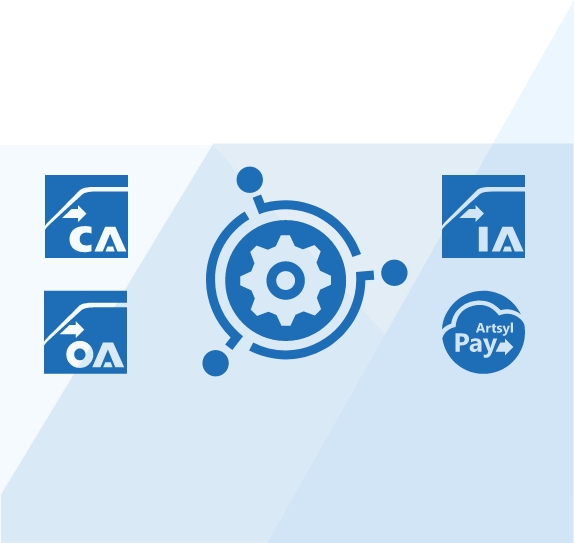Have you ever found yourself buried under piles of invoices, struggling to keep track of what needs to be paid and when? Handling accounts payable (AP) can be a challenging task, especially when done manually. Moreover, manual AP processing may result in costly errors, delayed payments, or even missed deadlines.
That’s where AP workflow automation comes in – it’s a powerful tool that can help you streamline and optimize your payment processing, reduce costs, increase efficiency, and improve accuracy. In this blog post, we’ll explore what AP workflow automation is, why you should consider implementing it, and how it can benefit your business.

Tired of dealing with manual errors and delayed invoice approvals?
Click here to discover how InvoiceAction AP Workflow Automation can streamline your operations, reduce your overhead, and let you focus on growing your business. Unlock the efficiency you’ve always dreamed of today!
What is AP Workflow Automation?
AP workflow automation is the use of software solutions to automate and optimize the AP process from invoice receipt to payment processing. Automated AP workflows can route invoices through a series of predefined approval stages, match invoices to purchase orders (POs) or receipt documents, flag exceptions and discrepancies, and post approved invoices for payment.
Automation can also help you capture data from invoices and store it electronically, enabling quick and easy access to information, reducing the risk of errors, and facilitating reporting and analytics.
Intelligent Process Automation Solution
Related Videos
Benefits of AP Workflow Automation
There are several benefits to automating the AP workflow, including:
- Increased Efficiency — Automated AP workflows eliminate manual tasks, enabling teams to focus on higher-value work and reducing processing time and costs.
- Improved Accuracy — AP automation can reduce errors and exceptions, ensuring that invoices are processed accurately, reducing risk, and increasing compliance.
- Better Cash Flow Visibility — Automation provides real-time visibility into invoice status, enabling businesses to forecast cash flow, manage cash effectively, and make sound financial decisions.
- Better Vendor Relations — Automated AP workflows can provide faster, more accurate payments, reducing the risk of late payments, improving vendor relationships, and strengthening your supply chain.
- Scalability — AP automation solutions are designed to scale and adapt to the changing needs of your business, helping you achieve your long-term goals and objectives.
Are you in the dark when it comes to your accounts payable? Don’t just guess—know. With InvoiceAction AP Workflow Automation, you can have real-time insights at your fingertips. Click here to learn more and start making data-driven decisions that make a difference.
Book a demo now
How AP Workflow Process Works
The basic steps in an automated AP workflow process include:
- Invoice Receipt — Automated AP workflows can capture invoices from email, PDF, or scan and extract relevant data.
- Invoice Approval — Invoices can be automatically routed to the appropriate approver based on predefined rules, typically incorporating PO matching and exception handling.
- Coding and Validation — Invoice data can be automatically coded, validated and matched to PO and receipt data, improving accuracy and compliance.
Posting and Payment — Once an invoice has been approved, it can be automatically posted for payment, based on predefined payment terms, methods, and schedules.
AP Approval Workflow: What Is It?
Accounts Payable approval workflow, also known as AP approval workflow, is a systematic set of processes used to manage and coordinate the manner in which supplier invoices are approved before payment is made.
In many organizations, approval workflows are increasingly becoming automated thanks to advancements in software technology. However, these workflows can still be managed manually, depending on the size and complexity of an organization.
Effective AP Approval Workflows are crucial for maintaining strong supplier relationships, ensuring compliance, improving operational efficiency, and providing an audit trail for financial oversight. Here are some typical steps involved in an AP approval workflow:
- Invoice Receipt: The process usually starts when an invoice is received, either by mail, email, or any other method of delivery. This invoice is then entered into the accounting or ERP system for tracking and payment.
- Invoice Verification: The accounts payable department verifies the information on the invoice to ensure it matches with the purchase orders, contracts, or delivery receipts. Verification often includes checking for correct pricing, quantities, terms, and other pertinent details.
- Coding and Indexing: After verification, the invoice is coded with the appropriate general ledger accounts and cost centers. This allows the expense to be tracked and allocated correctly within the financial system.
- Approval Routing: The invoice is routed to the appropriate individuals or departments for approval. In some cases, there may be multiple layers of approval required based on the amount or nature of the purchase.
- Exception Handling: If there are discrepancies or issues found during the approval process, the invoice may be flagged for review. This often requires coordination between accounts payable, purchasing, and the supplier to resolve.
- Payment Authorization: Once the invoice has been approved by all required parties, it is ready for payment. The payment is then scheduled based on the terms agreed with the supplier.
- Audit Trail: All steps, including approvals and communications, are documented for compliance and auditing purposes.
- Payment and Reconciliation: Finally, payment is made to the supplier, and the invoice is marked as paid in the accounting system. Any supporting documentation is archived for future reference.
- Reporting and Analytics: Metrics related to the AP process, like processing times, errors, and costs, are analyzed to identify areas for improvement.
With the aid of Artsyl InvoiceAction solution, many of these steps can be automated to improve efficiency, reduce errors, and enhance visibility into the accounts payable process. Intelligent automation platform docAlpha allows for electronic routing of invoices, real-time status tracking, mobile approvals, and integration with existing accounting or ERP systems.
Ready to transform your accounts payable from a cost center to a strategic asset? Explore how InvoiceAction AP Workflow Automation can offer seamless invoice approvals, advanced analytics, and unparalleled compliance features. Click here to start your transformation journey!
Book a demo now
How Different is AP Invoice Workflow?
The terms «AP Approval Workflow» and «AP Invoice Workflow» are often used interchangeably, but they can refer to slightly different aspects of the accounts payable process.
AP Approval Workflow
This primarily focuses on the approval aspect of handling an invoice. It details the hierarchical or departmental steps an invoice goes through to get approved for payment. This usually includes verification against purchase orders, budget checking, and obtaining necessary managerial sign-offs.
The key aim is to validate that the invoice is legitimate, accurate, and in accordance with company policies before payment is released. The process typically encompasses invoice verification, coding, routing for approvals, exception handling, and finally, payment authorization.
AP Invoice Workflow
This is a broader term that refers to the end-to-end process of handling an invoice from the moment it is received until it is paid and archived. While the approval workflow is a subset of this, the AP Invoice Workflow could also include steps like invoice capture, digitization (in case of paper or non-digital invoices), three-way matching (comparing invoices, purchase orders, and delivery receipts), dispute management, payment processing, and even post-payment analytics. The goal is not just approval but efficient, accurate, and timely payment alongside compliance and record-keeping.
Similarities and Differences: AP Invoice Workflow vs AP Approval Workflow
Both workflows aim to ensure that only legitimate and accurate invoices are paid, but they do so with a different scope:
- Scope: AP Invoice Workflow is generally broader and covers more steps, including pre-approval and post-approval activities. AP Approval Workflow is primarily concerned with the approval steps that occur between invoice capture and payment.
- Complexity: AP Invoice Workflow may deal with more complex issues like invoice capture, data extraction, and post-payment analysis, while AP Approval Workflow mainly focuses on validation and authorization.
- Integration: AP Invoice Workflow often requires integration with other systems like procurement, inventory management, and general ledger for end-to-end processing. AP Approval Workflow might only involve the accounts payable system and email or other approval mechanisms.
- Key Stakeholders: AP Invoice Workflow could involve multiple departments such as procurement, accounts payable, and finance. AP Approval Workflow might primarily involve accounts payable and the department or individual responsible for the purchase.
- Compliance and Auditing: Both workflows are essential for compliance, but the AP Invoice Workflow is generally more comprehensive as it includes the archiving and reporting steps essential for audit trails.
- AP Workflow Automation: Both AP workflows can be automated, but automating an AP Invoice Workflow could be more complex due to its broader scope and the need for integration with other systems.
In summary, the AP Invoice Workflow is generally a more comprehensive view of the entire invoice-to-pay process, while AP Approval Workflow focuses more specifically on the validation and authorization steps within that broader context.
Automation is the future, and the future is now. Simplify your AP processes, eliminate manual tasks, and achieve operational excellence with InvoiceAction. Go ahead and book a free demo and see the difference automation can make for your business.
Book a demo now
AP Invoice Approval Workflow Setup and Usage
Setting up and using an AP (Accounts Payable) Invoice Approval Workflow can vary depending on the specific needs of your organization and regulatory requirements. However, there are some general steps that are commonly followed.
- Configuration: Configure Artsyl docAlpha platform with InvoiceAction according to your approval criteria, routing rules, and roles for each user.
- Integration: Integrate Artsyl docAlpha platform with InvoiceAction with your existing accounting or ERP system for seamless data flow.
- Testing: Before full implementation, test the integration to ensure that it meets your needs and complies with your rules and regulations.
Automated AP Workflow Usage
Invoice Capture: Use InvoiceAction software to capture and digitize incoming invoices automatically.
Automated Routing: InvoiceAction software routes the invoice to the appropriate approvers based on pre-set criteria.
Electronic Approvals: Approvers can approve or reject invoices electronically through a user-friendly InvoiceAction dashboard.
Exception Handling: Automatically flag discrepancies for review and follow a predetermined process to resolve issues.
Payment Authorization: After successful approvals, InvoiceAction software can either automatically trigger payments or notify the AP department to do so manually.
Audit Trails: Maintain electronic logs of all actions for compliance and auditing.
Analytics and Reporting: Use built-in analytics tools to review performance metrics and identify bottlenecks or areas for improvement.
AP Workflow Automation Monitoring and Improvements
Regardless of whether you use a manual or automated system, it’s important to monitor the workflow regularly for efficiency and compliance and make adjustments as needed. Periodically review InvoiceAction setup to update approval hierarchies, routing rules, and other criteria to keep the workflow current and effective.
By following these general guidelines, you can set up and use an AP Invoice Approval Workflow that streamlines the invoice approval process, improves efficiency, reduces errors, and enhances compliance.
Why wait when you can take control today? With our risk-free trial, experience firsthand how InvoiceAction AP Workflow Automation can revolutionize your accounts payable processes. No more bottlenecks, no more compliance worries, just smooth and efficient workflows. Click here to start your risk-free trial and seize control of your AP operations now!
Book a demo now
Final Thoughts: Discover the Benefits of AP Workflow Automation
An automated AP workflow can enable organizations to streamline payment processing, reduce processing costs, improve accuracy, and increase efficiency. In addition, AP automation can provide real-time visibility into cash flow, increase compliance, and strengthen vendor relationships.
Moreover, AP workflow automation frees AP staff to focus on higher-value work, leading to improved productivity and job satisfaction. If your organization is still relying on manual AP processes, now is the time to explore automation solutions and take advantage of the benefits of AP workflow automation.


 AP Automation Benefits for Supply Chains
AP Automation Benefits for Supply Chains How to Build an Automated Invoice Processing Workflow
How to Build an Automated Invoice Processing Workflow Unravelling the Decision-Making Process in Accounts Payable Automation
Unravelling the Decision-Making Process in Accounts Payable Automation OCR Automation in the Digital Age
OCR Automation in the Digital Age AP Automation in Supply Chain Industry
AP Automation in Supply Chain Industry